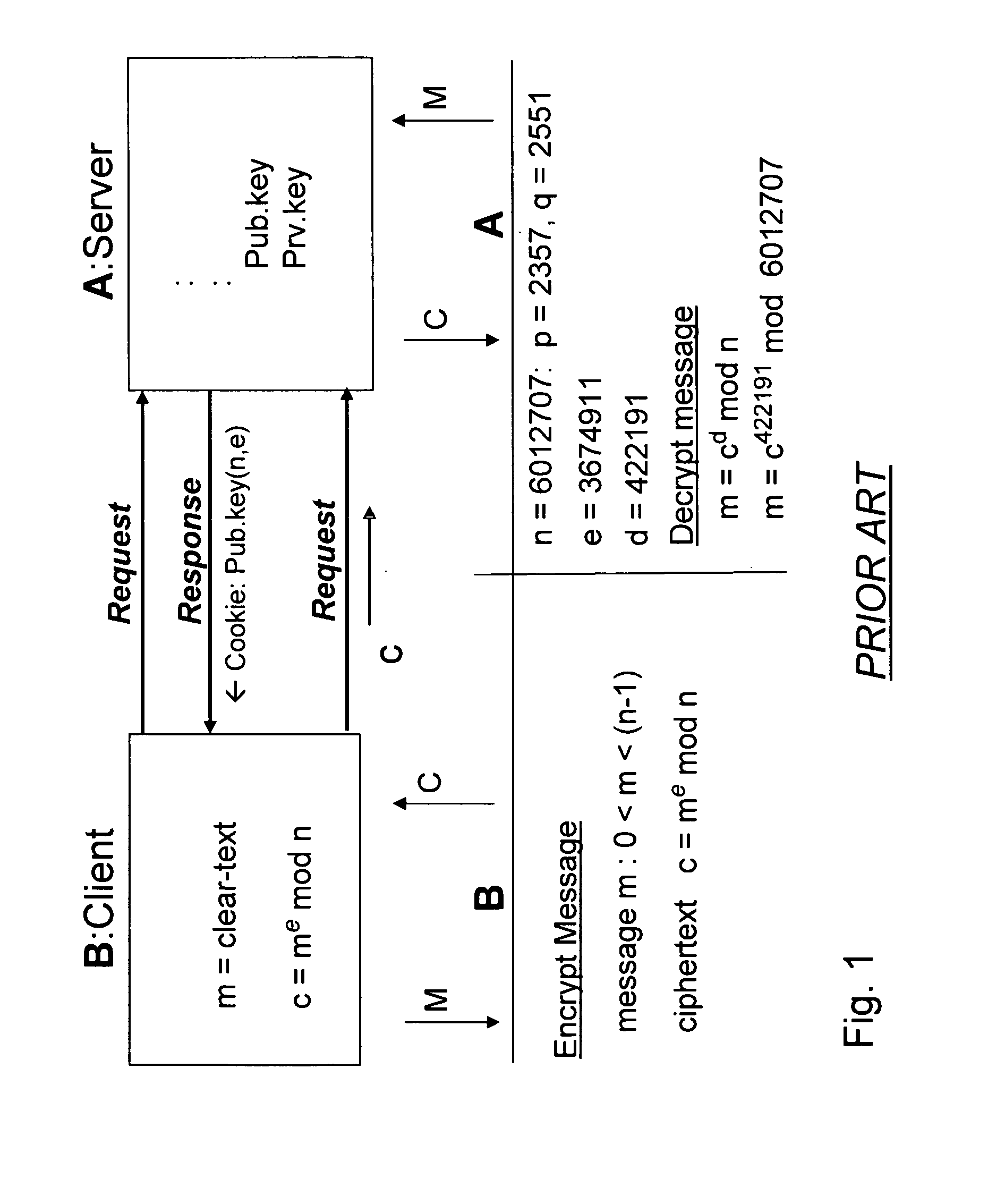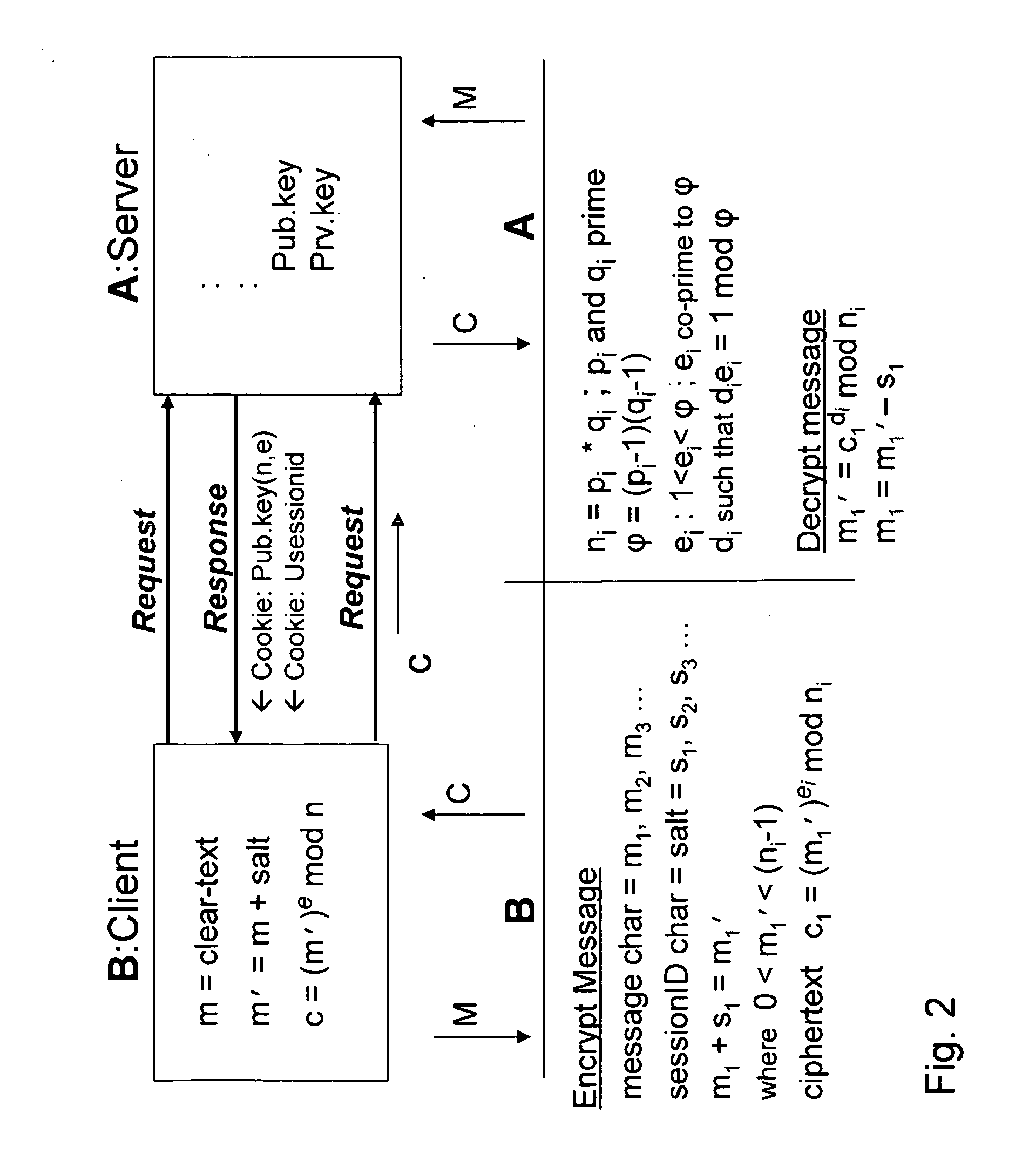Bcencryption (BCE) - a public-key based method to encrypt a data stream
- Summary
- Abstract
- Description
- Claims
- Application Information
AI Technical Summary
Benefits of technology
Problems solved by technology
Method used
Image
Examples
example one
[0056]In a general example, key generation for RSA public-key encryption includes each entity creating an RSA public key and a corresponding private key. For example, referring to FIG. 2, each entity A (such as, for example, a server) can perform the following steps: generate two large random (and distinct) primes p and q, each roughly the same size; compute n=pq and φ=(p−1)(q−1); select a random integer e, 1<e<φ, such that gcd(e,φ)=1, where gcd is the greatest common divisor function; and use the extended Euclidean algorithm to compute the unique integer d, wherein 1<d<φ, such that ed≡1(mod φ).
[0057]Still referring to FIG. 2, A's public key is (n,e), while A's private key is d. The integers e and d in RSA key generation are called the encryption exponent and the decryption exponent, respectively, while n is called the modulus. User B (or client B) can encrypt a message m for entity A, which A subsequently can decrypt, by the following steps: obtain A's authentic public key (n,e); r...
example two
[0061]To generate a key with the RSA encryption method according to a further embodiment, entity A can choose the primes p=2357, q=2551, such as illustrated in FIG. 1, and computes n=p*q=6012707 and φ=(p−1)(q−1)=6007800. A chooses e=3674911 and, using the extended Euclidean algorithm, finds d=422191 such that ed≡1 (mod φ). A's public key is the pair (n=6012707; e=3674911), while A's private key is d=422191. According to an embodiment of the invention a message character value is salted by concatenation with a character from the session ID string. If such concatenation were to yield the number 5234673 (i.e., m′=m+s=5234673), then to encrypt a salted message character, B uses an algorithm for modular exponentiation to compute the ciphertext c=(m′)e (mod n)=(5234673)3674911 mod 6012707=3650502, and sends this ciphertext to A. To decrypt the ciphertext c, A computes m′=cd (mod n)=3650502422191 mod 6012707=5234673, which recovers m′.
example three
[0062]A sample session ID string can be “6C655A654B654432D5FF56.” To use this session ID string as part of an encryption operator, if the salt character used (or its hexadecimal representation) is an even number, then the ASCII value of the salt s can be added to a first message value, m, to yield an interim, salted message value m′,
m′=m+s
where the ciphertext is then formed by
c=(m′)e(mod n)
Then, if c is less than 10 or less than 100, two leading zeros or one leading zero, respectively, can used to pad the value c for a consistent 3-character ciphertext value.
[0063]To decrypt the ciphertext, if the salt character used (or its hexadecimal representation) is an even number, then the decryption operation includes subtracting the salt value from the interim message value, m′, that is regained from the decryption calculation
m′=cd(mod n)
in order to obtain the original message character, m, as follows
m=m′−s
If the salt character used is an odd number, then, to encrypt, the ASCII value of t...
PUM
 Login to View More
Login to View More Abstract
Description
Claims
Application Information
 Login to View More
Login to View More - R&D
- Intellectual Property
- Life Sciences
- Materials
- Tech Scout
- Unparalleled Data Quality
- Higher Quality Content
- 60% Fewer Hallucinations
Browse by: Latest US Patents, China's latest patents, Technical Efficacy Thesaurus, Application Domain, Technology Topic, Popular Technical Reports.
© 2025 PatSnap. All rights reserved.Legal|Privacy policy|Modern Slavery Act Transparency Statement|Sitemap|About US| Contact US: help@patsnap.com



